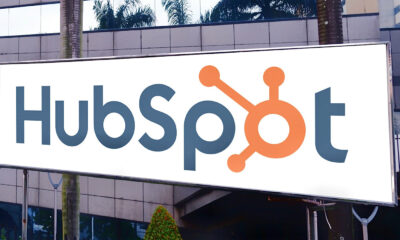MARKETING
16 Tips and Tricks from HubSpot Insiders

If you work 40 hours a week, 52 weeks a year, that’s over 2,000 hours a year spent with the same coworkers (give or take a vacation or two, of course). Therefore, if it isn’t already your top priority, being a great coworker definitely should be.
Strong relationships are the foundation of a positive work environment and set the tone for nearly your entire work life. Even if you hate how Jim blows his nose at his desk, or you cringe every time Stacy brings up her cats, these people greatly influence your work day-to-day.
The bottom line is that collaboration and connection will get you much farther than you may think. (Trust us! Hubspot has been named #1 for happiest employees and #2 for best place to work.) For our exclusive insider tips, keep reading.
How to Be a Great Coworker
- Appreciate and acknowledge.
- Respond to emails or calls promptly.
- Be reliable.
- Be humble.
- Create clear documentation.
- Reach out to new teammates.
- Steer clear of gossip.
- Avoid annoying office habits (remote or in person).
- Share your resources.
- Gather feedback.
- Be respectful of people’s time.
- Find ways to connect online.
- Make valuable introductions.
- Get coworker buy-in.
- Lighten the OOO workload.
- Listen.
1. Appreciate and acknowledge.
When people feel unappreciated in the workplace, it becomes increasingly difficult for them to see the benefit of going that extra mile. With no recognition, there’s little motivation to continue.
That’s where you come in. Whether you’re a manager or just a grateful peer, make an effort to give credit.
Taking time in a meeting to give kudos, writing an email, or sending a Slack message takes minutes. However, this gesture can make someone’s entire day.
“As an intern, I assumed I would mostly go unnoticed and fly under the radar in my day-to-day work. However, this summer, I never felt so uplifted and praised for the hard work I was contributing to my team,” says one incoming HubSpot marketing associate and summer 2022 marketing intern. “Even my out-of-office accomplishments were recognized!”
2. Respond to emails or calls promptly.
Everyone has a job to do. And if your approval or feedback is required for one of your coworkers to move the needle on a project, don’t make them wait.
Bottlenecking a project is not only frustrating, but it can also have a significant impact on a person’s ability to reach team or company-wide goals.
Pro tip: If you’re unsure whether or not you’re guilty of this, ask your teammates to specify a time frame within the body of their emails to help you keep track of priorities.
If you don’t have time to respond immediately, one HubSpotter suggests shooting them a quick ‘I’m held up right now, but I’ll look this over this afternoon or tomorrow’ message.”
3. Be reliable.
Outside of prompt email responses, being reliable overall will go a long way. Your coworkers want to know they can trust you to complete assignments, offer support, and provide assistance during tough times.
Reliability not only improves your relationships. You’ll also play an important role in pushing projects across the finish line.
“To me, a great coworker is a reliable coworker, someone I know will get things done one time and with great execution,” says Jamie Juviler, a marketing manager at HubSpot. “That’s especially important in projects with many stakeholders and moving parts. If everyone stays on track, things get done.”
4. Be humble.
Being humble doesn’t mean selling yourself short. Instead, humility actually shows that you have a clear perspective, and you’re self-aware. In fact, this attitude is one of HubSpot’s core values.
In an office setting, this ability to recognize your own limitations can make it easier for you to build meaningful relationships with your coworkers. You’ll also be able to ask for help when needed, which improves the quality of your work.
Pro tip: Ask your colleagues for assistance when needed. This signals to them that you’re open to other ideas. They’ll also feel comfortable reaching out to you for your expertise in the future. Sounds like a win-win!
5. Create clear documentation.
You may be great at your job, but your impact will be minimized if no one knows what you do.
Take the time to clearly document your role, how you complete these tasks, and which processes you own. A few written documents (or even bullet points) can help people understand how to work best with you.
“Whether you’re in a small or large team, taking the time for proper process, project, or training documentation will make you the ultimate team player — all while saving you some time in the long run,” says Bianca D’Agostino, a senior marketing manager and SEO strategist at HubSpot.
Documentation becomes even more important if you are at a global company with employees in different time zones.
“My teammates and I take extra time and care noting down what we know, what we’re asking of each other, and being super transparent about our timelines/goals,” D’Agostino adds. “Since our team is global and scattered across a few different time zones, this skill has made our team so much stronger!”
6. Reach out to new teammates.
New job nerves are the pits. You toss and turn the night before your big first day, worrying about everything from what shirt will look best to whether or not your fun facts actually are some semblance of fun.
Experienced workers, do your part to help new team members feel at ease. Make an effort to help them get situated during their first few days or weeks on the job.
“It’s always awkward being the ‘noob’ walking into a room of unfamiliar people, so sit next to them at their first meeting. It’s a small gesture that will make them feel all the more welcome,” suggests Anum Hussain, a former team manager at HubSpot. Today, Anum is the head of content marketing and audience growth at Reforge.
Pro tip: Ask your new teammates welcoming questions, or invite them to join you for lunch (either in-person or virtually).
7. Steer clear of gossip.
Ah, the office water cooler. Whether in an office or on a Zoom call, we all can fall victim to slipping in a cheeky comment or two.
It’s easy to get caught up in complaining about Steve’s work ethic or to gush about a suspicious relationship between two interns. However, engaging in office gossip is both risky and unprofessional. Plus, gossip can result in some pretty sticky situations.
Pro tip: Keep lines of communication open. The more transparent and honest you and your team are with one another, the less room there is for speculation.
(Want more on this? Check out this post on how to deal with office politics).
8. Avoid annoying office habits (remote or in person).
We all have quirks and idiosyncrasies. Even so, self-awareness matters, as does keeping tabs on behaviors that rub colleagues the wrong way.
So which office habits are considered annoying? In 2022, Quality Logo Products surveyed over 1,900 workers to find out. Interrupting (48%), taking credit for someone else’s work (47%), and oversharing (45%) ranked among the most annoying behaviors.

Working remotely doesn’t automatically solve the problem. Quality Logo Products found that remote workers face a different set of challenges.
Slow responses to emails or instant messages ranked as the most annoying behavior in remote colleagues at 48%. Background noise during calls (47%) and eating on camera (43%) were also at the top of the list.

The lesson: Be considerate of others and how you are in each space. If you share a common space such as a meeting room, be sure to clean up after yourself. If you’re on a Zoom call, be aware of your settings. These are simple tasks that truly go a long way for everyone around you.
“It took me a few weeks into my first job out of college to realize just how loud my chewing was in the roomful of quiet, concentrating people. Were my coworkers wearing headphones because they liked listening to music, or because I’d been chowing down on carrots for the last 20 minutes?” jokes Lindsay Kolowich Cox, a former marketer at HubSpot.
For more tips on how to be more considerate in the office, check out Lindsay’s article on breaking annoying office habits.
9. Share your resources.
Take a look at the people you work closely with. They’ve all been hired for a reason, right? Maybe Nathan is really great at problem-solving, while Sue can negotiate like no other. There’s something you can learn from everyone.
Regardless of our unique strengths and specific titles, sharing helpful resources can benefit your whole team.
“Find something particularly inspiring or thought-provoking? Whether it’s a blog post or intriguing design, it could be just what your neighbor needs to kickstart their big project,” insists one HubSpotter.
10. Gather feedback.
Competition hurts collaboration. Make sure your team has a psychologically safe environment where they feel encouraged to share ideas. That can include offering suggestions or pitching something entirely new.
“One of the biggest, and sometimes hardest, things you can do as a teammate is giving space to other coworkers to pitch their ideas and suggestions (even if you disagree with them),” says Pamela Bump, the manager of HubSpot’s Growth Team.
“When you work with or manage a team, it’s easy to hog the keys to the car. Because many workplaces can feel competitive, this is an instinct we all struggle to shove off.”
If you struggle with creating the space for contribution, remember that more voices can unlock new perspectives. A colleague can help you solve that problem you’ve been struggling with for months.
“Especially when building something from scratch, more voices can lead to more success,” Bump says. “By building a time or space for people to share their thoughts … you can get those great perspectives without getting overwhelmed by too much feedback.”
Pro tip: Consider building a feedback session into your meetings, holding a dedicated brainstorming workshop, or creating a collaborative Google Doc to gather ideas.
11. Be respectful of people’s time.
It’s no secret that we are all busy. Often, we wish there were more than 24 hours in a day.
While you can’t resolve these problems with the wave of a wand, you can take small steps by respecting your coworkers’ time. Be aware that 5 minutes here and 20 minutes there can add up during the day. Make an effort to show up on time and come prepared.
“If a meeting ends early, don’t try to fill the time. If a meeting doesn’t need to happen anymore, cancel it. Being respectful of people’s time is appreciated,” urges a HubSpotter.
12. Find ways to connect online.
If you work in a hybrid or remote environment, you’ll need to try a bit harder to form close connections with coworkers. Instead of being able to peer over your cubicle to say hi to neighbors, you now have to schedule in time for those casual catch-ups.
Pro tip: Set up weekly Zoom lunches, monthly team show-and-tells, or just ping a friend living across the country to grab a virtual coffee. These simple conversations go a long way, especially when it’s so easy to get caught up in heads-down work at home.
Aside from being a great excuse to socialize during the day, they provide a shared experience to look forward to while strengthening your company’s identity and culture.
13. Make valuable introductions.
Heard one of your coworkers is looking for a freelancer for the project they’re working on? If you know just the person, make a connection.
“Two networks are always better than one,” insists Eric Peters, a product lead at HubSpot.
Help your coworkers achieve their goals by making introductions between folks who would benefit from knowing each other.
Maybe you recommend a potential candidate for an open position or connect a new hire with a tenured employee to provide them with some guidance. These intros show that you’re a team player.
14. Get coworker buy-in.
If you’re running a project or initiative, make sure your coworkers feel connected toward their work. A common mission improves the culture of your team and strengthens colleague relationships.
“When you include people, try their ideas, or even just take the time to hear them out, they feel included — even if you respectfully disagree with one or two suggestions,” suggests Bump. “Involving your team will motivate them around a joint project which will be good for you and them in the long run.”
Buy-in creates a better work experience and establishes you as a trusting, empathetic colleague.
“Many will even want to work with you more often,” Bump says, “all because YOU gave them a platform to speak when others would have just micromanaged.”
15. Lighten the OOO workload.
Anytime you miss a couple of hours or days in the office — whether for personal reasons, a vacation, or an illness — it’s easy to get overwhelmed.
With this feeling in mind, act accordingly: Help your coworkers avoid this vicious cycle by stepping in to lend a helping hand when and where you can.
“Offer to help take over some of their work so they don’t come back to a pile of it and won’t worry about getting stuff done when they need to be away,” suggests Corey Wainwright, HubSpot’s former director of content.
Even if you can’t add more to your plate, remember to act with empathy and remind your colleague that they should take whatever time they need to catch up. There’s no need to make up all of the work in one day.
16. Listen.
Often, the most helpful thing you can do for a coworker is to give them a chance to talk through something. Whether it’s regarding their strategy to approach a complicated task or solely to share how much is going on in their personal lives and how they feel overwhelmed.
Active listening is a skill that will help you empathize with what your coworker is going through, even if you can’t put yourself in their shoes directly.
“I appreciate a teammate who is an active listener. I like to feel like I’m being understood and listened to during conversations, and I hope my coworkers also feel that from me,” says Flori Needle, a marketing manager at HubSpot. “I let people know that I’m listening by asking follow-up questions and being engaged during conversations, and I appreciate the same from my coworkers.”
Pro tip: Sometimes, people don’t need you to propose a solution. Instead, they just need to hear their thoughts out loud. Lending that ear can go a lot farther than you may assume.
Furthermore, these small acts of kindness help establish trust and comradery, feelings that bolster a productive and effective work environment.
This post was originally published in 2016 and has been updated for comprehensiveness.

![16 Tips and Tricks from HubSpot Insiders → Click here to download leadership lessons from HubSpot founder, Dharmesh Shah [Free Guide].](https://articles.entireweb.com/wp-content/uploads/2022/01/How-to-be-a-Good-Leader-Research-Expert-Tips.png)





![How to Create A Website to Sell Products In 8 Steps [+6 Expert Tips] How to Create A Website to Sell Products In 8 Steps [+6 Expert Tips]](https://articles.entireweb.com/wp-content/uploads/2024/10/1727868370_How-to-Create-A-Website-to-Sell-Products-In-8.webp-400x240.webp)
![How to Create A Website to Sell Products In 8 Steps [+6 Expert Tips] How to Create A Website to Sell Products In 8 Steps [+6 Expert Tips]](https://articles.entireweb.com/wp-content/uploads/2024/10/1727868370_How-to-Create-A-Website-to-Sell-Products-In-8.webp-80x80.webp)






You must be logged in to post a comment Login